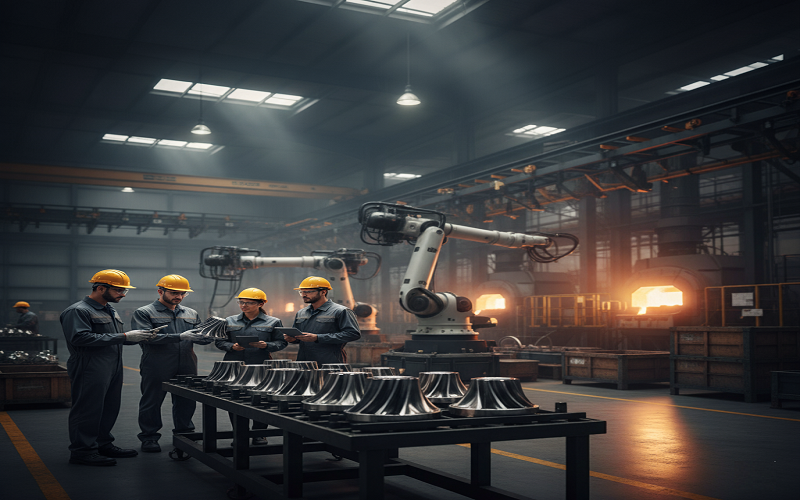Investment casting may sound like a modern industrial invention, but people have used the method for thousands of years. Advances in technology, improved precision, and a wider range of alloys have transformed the process. Today, industries use investment casting to manufacture complex, high-precision metal parts for aerospace, defense, energy, automotive, medical devices, and more. So what is involved in the casting process? How do Investment castings manufacturers start with the wax pattern process that is converted into a strong metal part capable of withstanding high temperatures? Let’s keep reading below!
One can see why if one understands the entire process, step by step. What is best about investment casting is that each step adds to the overall accuracy, strength and repeatability.
Creating the Wax Pattern
It all starts with a wax mold of the end product. All lines, proportions, curves, and every part of each edge and face must be exquisitely rendered. Other forming methods shape the metal directly, but investment casting achieves precision through the wax. The wax pattern can be formed by:
Injection molds for mass production
Knowing about custom parts it’s also possible to make use of rapid prototyping / 3D printing. The surface of the wax pattern reveals directly in the resulting surface finish of the metal cast. Here is the reason why we carefully verify each and every pattern on our way.
Building the Wax Tree Assembly
Tiny parts are not individually painted. Instead, technicians connect the individual wax patterns to a single central wax runner system, called a tree.This is starting to resemble a tree for wax mannequins. The tree shape allows molten metal to flow in dividable casting, so more than one part can be produced in the same pour. Constructing the tree also diminishes time of casting and component cost for each reaction.
Applying the Ceramic Shell
Then the wax assembly is dipped into a slurry composed by fine ceramic material. After a dip, grit is thrown on top of the wet layer as strength accumulates like sandy ceramics.Investment casting manufacturers repeat this step multiple times to build several strong ceramic layers. They then dry the shell and re-dip it, continuing the process until the ceramic layers become robust.
The ceramic shell serves two primary functions:
- It shapes the external geometry
- Which protect against liquid metals.
- The shell within it that give investment casting its ability to withstand temperature and create complex parts without warping.
Dewaxing the Mold
Take out the wax once the ceramic shell is sturdy. The shell is cured in furnace or steam autoclave. The wax melts and flows away, creating an empty space an exact inverse of the final metal piece. Many modern foundries recycle recovered wax, making the process both sustainable and cost-effective.
Pre-Heating the Shell
The empty ceramic is fired to an extremely high temperature before pouring of the metal. This thus lowers a risk of thermal shock and promotes flowing of molten metal in cavity. Preheating also avoids premature solidification of the metal so that it can flow into every nook and cranny of the mold.
Pouring the Molten Metal
Now the key moment arrives. Foundries melt the chosen alloy—stainless steel, carbon steel, aluminum, bronze, cobalt, nickel, and others—in a furnace and pour it into the still-heated shell. For applications requiring high cleanliness, such as aerospace or medical implants, technicians perform the casting in a vacuum or inert atmosphere to prevent contamination.
This stage decides:
- Internal strength
- Density
- Structural soundness
- Increased metallurgical quality is obtained by a smooth filling with low porosity. The metal is cooled and solidified within the ceramic shell.
Removing the Ceramic Shell
After the metal solidifies, technicians remove the ceramic shell, typically using mechanical vibration, water blasting, or hammering. As a result, the metal tree quickly emerges as an accurate metallic version of the wax tree created earlier. Now you’re able to see some of the cast bits connected to a metal runner system.
Cutting and Finishing
The cast parts are trimmed from the runner and sent to finishing. Finish, by design and application, may include:
- Shot blasting or sand blasting
- Grinding or polishing
- Strength or hardness heat treatment
- CNC machining for tight tolerances
- Inspection for quality acceptance never-destructive testing (NDT)
- One of the great benefits of investment casting is that we typically require very little machining because cast parts are accurate and smooth.
Reasons behind the Popularity of Investment Casting
- It may sound like a lot but each step leads to amazing rewards:
- Dimensional accuracy with tight tolerances
- Good surface finish without heavy machining
- Capable of generating highly complex and thin-wall parts
- Extensive material choice, such as heat resistant super alloys
- Low and high production cost-effective
Items produced through investment casting can be subjected to all manner of loads, corrosion resistance, high temperatures and wear which is why vital industries rely on the process so heavily.
Common Components Made Through Investment Casting
By contrast, investment cast parts are sprinkled throughout the bike in places not many people even notice:
- Aircraft engine blades and airframes
- Dental and orthopedic implants
- Defence weapon systems
- Turbo and superchargers, exhaust components, transmissions
- Pump impellers and valve bodies
- Industrial machinery turbines and power plant equipment
You can find an investment casting tool maker that specializes in producing everything from small medical parts to heavy-duty engineering components.
Conclusion
The science of investment casting is an ideal marriage between engineering and material science. From a basic wax shape to high quality metal parts, each process evolves the material into product strong enough to handle tough applications. The method has existed for hundreds of years, but with industries increasingly demanding lightweight and complex metal products, it is more relevant than ever.
But investment casting is much more than a technique; it serves as a bridge between what can be imagined and what can be realized, enabling designers to produce forms that were previously unthinkable and offers engineers the freedom to build elements now only just being understood.



